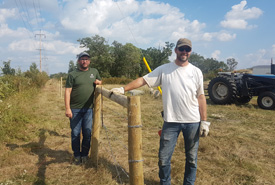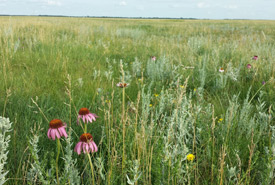Please fence me in

Tim Teetaert and Stephen Gietz installing fences at the Manitoba Tall Grass Prairie Preserve (Photo by NCC)
If you drove down Manitoba Provincial Road 201 this past summer, you may have seen Nature Conservancy of Canada (NCC) staffers installing fencing along a portion of NCC land at the Manitoba Tall Grass Prairie Preserve. You may have even asked yourself, “Why is a conservation organization fencing in an endangered habitat?”
Good question.
NCC works in Manitoba and elsewhere in Canada to conserve one of the most endangered terrestrial habitats on Earth: temperate grasslands.
Temperate grasslands evolved over thousands of years with regular and major disturbances, such as fire, enormous bison herds and locust outbreaks. The species that make up these grasslands can cope with these disturbances, and many of them will actually decline or even disappear without them. While Rocky Mountain locusts are now extinct, NCC does use prescribed fire and grazing to maintain the natural disturbances that grasslands, including endangered tall grass prairie, require to remain healthy.

Grasslands (Photo by NCC)
So, grasslands need regular disturbances, and cattle can help! NCC works with local livestock producers to graze the tall grass prairie in a way that helps maintain the incredible diversity of plains plants and animals. Fences are key in keeping cattle in the pasture and managing their movements on the prairie in a way that benefits both the animals and the ecosystem. And…people really don’t appreciate having herds of cattle roaming freely across the highway, in their flower gardens or across the playground.
Hence, the fence.
To learn more and transport yourself to this important natural area, listen to Episode 6 of our podcast, The Mystery of the Disappearing Butterfly.
NCC uses a wildlife-friendly fence design that works for both livestock management as well as large, roaming mammals. To learn more, click here.


